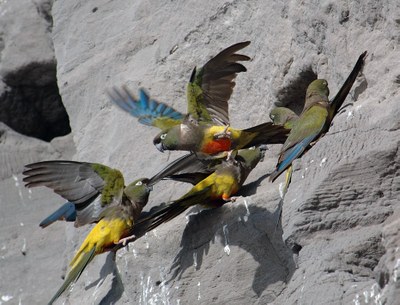Conservationists are sounding the alarm: parrots much more threatened than assumed
More than one hundred experts all around the world demand for conservation actions
No 172 • September 15th, 2017
deutsche Fassung
Many of the studied populations are on average exposed to ten different threats, most of them initiated by humankind. Agriculture, for example, affects 72 percent of populations, closely followed by the capture of parrots for the pet trade, which threatens 68 percent of populations. Natural vegetation clearing and other disturbances through human intrusions thus affect more than 55 percent of the examined populations – a result that implies a considerably higher risk than initially thought. In total, 63 percent of Latin American species were studied.
The results of the study show that the capture of wild parrots for the local pet trade correlates strongly with the decreasing population trends. Similar observations can be made with regard to the capture of wild parrots for international trade. The capture for international trade has been a major threat for parrots for decades, already in the 80s and 90s millions of them have been captured in Latin America and imported to the U.S., to Europe as well as to Japan. Intensive poaching led to the extinction of many parrots and is probably the main reason why there are no more free-living Spix Macaws.
Initiatives as the U.S. Wild Bird Conservation Act (1992) or the ban on imports of the European Union (2007) limited the trade in these huge markets, although South America, Southeast Asia and the Middle East still play a major role for the legal and illegal trade of wild parrots. According to the study, Bolivia, Brazil, Mexico and Peru have a flourishing parrot trade, for other countries even continued poaching is reported.
The findings suggest that effective measures need to be implemented urgently and should primarily aim at a prevention of the capture of wild parrots for the pet trade and the protection of parrot populations located near agricultural areas.
- Publication
Berkunsky, I., Quillfeldt, P., Brightsmith, D.J., Abbud, M.C., Aguilar, J.M.R.E., Alemán-Zelaya, U., Aramburú, R.M., Arce Arias, A., Balas McNab, R., Balsby, T.J.S., Barredo Barberena, J.M., Beissinger, S.R., Rosales, M., Berg, K.S., Bianchi, C.A., Blanco, E., Bodrati, A., Bonilla-Ruz, C., Botero-Delgadillo, E., Canavelli, S.B., Caparroz, R., Cepeda, R.E., Chassot, O., Cinta-Magallón, C., Cockle, K.L., Daniele, G., de Araujo, C.B., de Barbosa, A.E., de Moura, L.N., Del Castillo, H., Díaz, S., Díaz-Luque, J.A., Douglas, L., Figueroa Rodríguez, A., García-Anleu, R.A., Gilardi, J.D., Grilli, P.G., Guix, J.C., Hernández, M., Hernández-Muñoz, A., Hiraldo, F., Horstman, E., Ibarra Portillo, R., Isacch, J.P., Jiménez, J.E., Joyner, L., Juarez, M., Kacoliris, F.P., Kanaan, V.T., Klemann-Júnior, L., Latta, S.C., Lee, A.T.K., Lesterhuis, A., Lezama-López, M., Lugarini, C., Marateo, G., Marinelli, C.B., Martínez, J., McReynolds, M.S., Mejia Urbina, C.R., Monge-Arias, G., Monterrubio-Rico, T.C., Nunes, A.P., Nunes, F., Olaciregui, C., Ortega-Arguelles, J., Pacifico, E., Pagano, L., Politi, N., Ponce-Santizo, G., Portillo Reyes, H.O., Prestes, N.P., Presti, F., Renton, K., Reyes-Macedo, G., Ringler, E., Rivera, L., Rodríguez-Ferraro, A., Rojas-Valverde, A.M., Rojas-Llanos, R.E., Rubio-Rocha, Y.G., Saidenberg, A.B.S., Salinas-Melgoza, A., Sanz, V., Schaefer, H.M., Scherer-Neto, P., Seixas, G.H.F., Serafini, P., Silveira, L.F., Sipinski, E.A.B., Somenzari, M., Susanibar, D., Tella, J.L., Torres-Sovero, C., Trofino-Falasco, C., Vargas-Rodríguez, R., Vázquez-Reyes, L.D., White Jr, T.H., Williams, S., Zarza, R. & Masello, J.F. (2017) Current threats faced by Neotropical parrot populations. Biological Conservation, 214, 278-287.
https://doi.org/10.1016/j.biocon.2017.08.016
- Contact
Dr. Juan F. Masello
Department of Animal Ecology & Systematics
Phone: +49 641 99-35775
Pressestelle der Justus-Liebig-Universität Gießen, Telefon: 0641 99-12041
